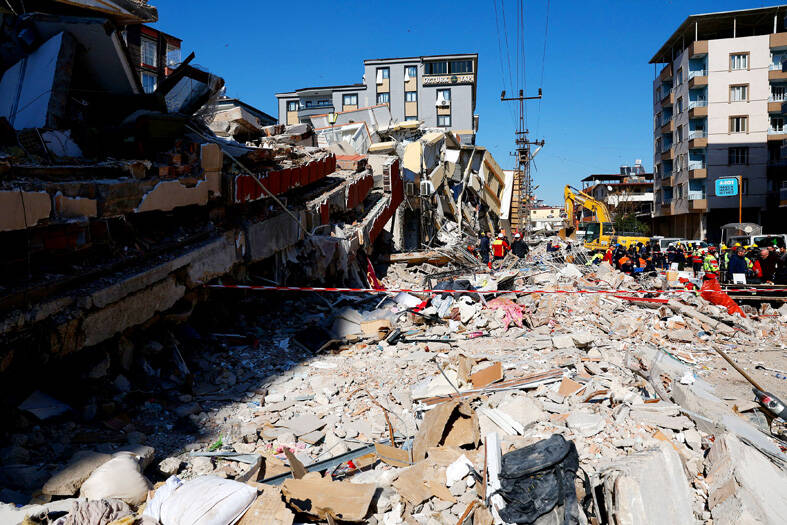How long can trapped people survive in the rubble of an earthquake?
Up to a week or more, experts say, but it depends on their injuries, how they are trapped and weather conditions.
Search teams from around the world have joined local emergency personnel in Turkey and Syria to look for victims from this week’s devastating earthquake that has killed thousands.

Photo: Reuters
Most rescues occur in the first 24 hours after a disaster. After that, survival chances drop as each day passes, experts say. Many victims are badly injured or buried by falling stones or other debris.
Access to water and air to breathe are crucial factors, along with weather. Wintry conditions in Syria and Turkey have hampered rescue efforts and temperatures have dipped well below freezing.
“Typically, it is rare to find survivors after the fifth to seventh days, and most search and rescue teams will consider stopping by then,’’ said Jarone Lee, an emergency and disaster medicine expert at Massachusetts General Hospital. “But, there are many stories of people surviving well past the seven-day mark. Unfortunately, these are usually rare and extraordinary cases.’’
People with traumatic injuries, including crush injuries and limb amputations, face the most critical survival window, said George Chiampas, an emergency medicine specialist at Northwestern University’s Feinberg medical school.
“If you don’t pull them out in one hour, in that golden hour, there’s really a very low chance of survival,’’ he said.
Those with other illnesses, whose health depends on medications, also face grim chances, Chiampas said.
Age, physical and mental condition are all critical.
“You see a lot of different scenarios where we’ve had some some really miraculous saves and people have survived under horrible conditions,” said Christopher Colwell, an emergency medicine specialists at the University of California, San Francisco. “They tend to be younger people and and have been fortunate enough to find either a pocket in the rubble or some way to access needed elements like air and water.’’
After the 2011 Japan earthquake and tsunami, a teenager and his 80-year-old grandmother were found alive after nine days trapped in their flattened home. The year before, a 16-year-old Haitian girl was rescued from earthquake rubble in Port-Au-Prince after 15 days.
Mental state can also affect survival. People trapped next to bodies, who have no contact with other survivors or rescuers, may give up hope, Chiampas noted.
“If you have someone who is alive, you’re leaning on each other to keep fighting,’’ he said.

May 11 to May 18 The original Taichung Railway Station was long thought to have been completely razed. Opening on May 15, 1905, the one-story wooden structure soon outgrew its purpose and was replaced in 1917 by a grandiose, Western-style station. During construction on the third-generation station in 2017, workers discovered the service pit for the original station’s locomotive depot. A year later, a small wooden building on site was determined by historians to be the first stationmaster’s office, built around 1908. With these findings, the Taichung Railway Station Cultural Park now boasts that it has

Wooden houses wedged between concrete, crumbling brick facades with roofs gaping to the sky, and tiled art deco buildings down narrow alleyways: Taichung Central District’s (中區) aging architecture reveals both the allure and reality of the old downtown. From Indigenous settlement to capital under Qing Dynasty rule through to Japanese colonization, Taichung’s Central District holds a long and layered history. The bygone beauty of its streets once earned it the nickname “Little Kyoto.” Since the late eighties, however, the shifting of economic and government centers westward signaled a gradual decline in the area’s evolving fortunes. With the regeneration of the once

The latest Formosa poll released at the end of last month shows confidence in President William Lai (賴清德) plunged 8.1 percent, while satisfaction with the Lai administration fared worse with a drop of 8.5 percent. Those lacking confidence in Lai jumped by 6 percent and dissatisfaction in his administration spiked up 6.7 percent. Confidence in Lai is still strong at 48.6 percent, compared to 43 percent lacking confidence — but this is his worst result overall since he took office. For the first time, dissatisfaction with his administration surpassed satisfaction, 47.3 to 47.1 percent. Though statistically a tie, for most

In February of this year the Taipei Times reported on the visit of Lienchiang County Commissioner Wang Chung-ming (王忠銘) of the Chinese Nationalist Party (KMT) and a delegation to a lantern festival in Fuzhou’s Mawei District in Fujian Province. “Today, Mawei and Matsu jointly marked the lantern festival,” Wang was quoted as saying, adding that both sides “being of one people,” is a cause for joy. Wang was passing around a common claim of officials of the People’s Republic of China (PRC) and the PRC’s allies and supporters in Taiwan — KMT and the Taiwan People’s Party — and elsewhere: Taiwan and